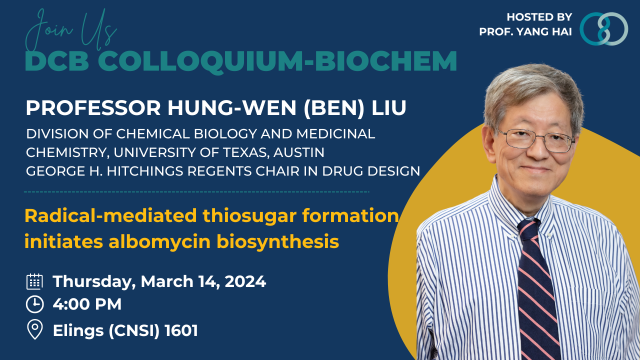Radical-mediated thiosugar formation initiates albomycin biosynthesis
Date and Time
Location
Elings (CNSI) room 1601 (in person only)

Hung-Wen (Ben) Liu
Prof. Hung-Wen (Ben) Liu, University of Texas, Austin
Thursday March 14, 2024 at 4:00 pm
Location: Elings (CNSI) room 1601 (in person only)
Host: Yang Hai
"Radical-mediated thiosugar formation initiates albomycin biosynthesis"
Albomycin δ2 is a nucleoside antibiotic possessing a unique thiofuranose moiety, which is essential for its activity against clinical pathogens. Previously described carbon-sulfur bond forming reactions in natural product biosynthesis have largely involved Lewis acid/base chemistry with relatively few examples catalyzed by radical S-adenosyl-L-methionine (SAM) enzymes. Moreover, the latter have been limited to radical-mediated sulfur insertion into C-H bonds with the sulfur atom originating in a sacrificial, auxiliary iron-sulfur cluster. Herein, a unique radical-mediated, sulfur-for-oxygen swapping reaction is identified in the biosynthesis of albomycin δ2. The swap is catalyzed by a twitch radical SAM enzyme AbmM encoded in the albomycin biosynthetic abm gene cluster and results in transformation of the furanose ring of cytidine 5′-diphosphate (CDP) to a thiofuranose thereby exchanging the bridging oxygen for sulfur. The incorporated sulfur appears to originate from an [Fe-S] cluster bound by AbmM rather than exogenous sulfide supplied in the bulk media. The multifunctional kinase AbmG, also encoded by the abm cluster, then catalyzes a rearrangement of the 4′-hydroxy-4′-thiofuranose intermediate to a 5′-oxo-4′-thiofuransoe facilitating entry into the albomycin δ2 biosynthetic pathway. Collectively, this work reveals a new mode of thiosugar biosynthesis that involves radical-mediated C–S bond formation.